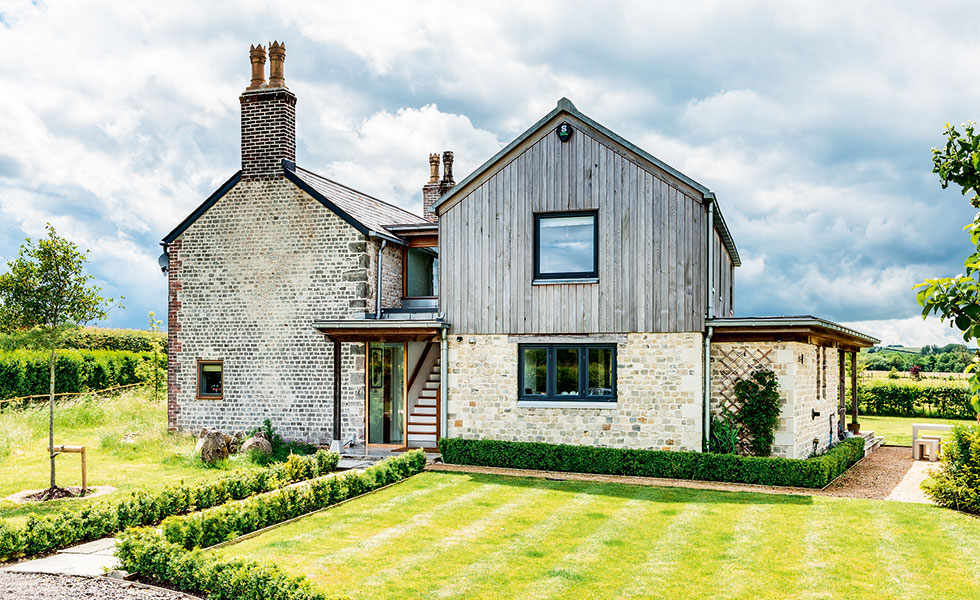Architectural Plans
Architectural Services
Contact Us
179 Edwin Road
Rainham,
Kent
ME8 0AH
Phone: 07957 350204
Email: info@architechnology.design
Company No: 12263820

If you’re planning on building an extension read our beginner’s guide on costs, planning permission and more before you start your build
If you need more space but you don’t want to move, then building an extension can be the answer.
But before you start your project, it pays to have an idea of what building an extension can entail. From the design stage through to planning, from working out costs and the actual build project – building an extension is a big commitment.
So to help your project run smoothly we’ve put together this beginner’s guide to building an extension, which provides a run-down of what you need to know before you start.

This listed cottage has been subject to a sensitive extension with glazed walls to let in lots of natural light
Depending where you are in the UK, for a straightforward extension you should allow around £1,000–£2,000/m2. But, the cost of your extension will all come down to a number of factors, including size, specification and location.
Building a single-storey extension will cost the following per/m2:
Remember: Be mindful of ceiling prices in your area — you’ll want to make a return on the money you spend on an extension so make sure the numbers add up.
Building a two-storey extension will not cost much more per square metre because, aside from the extra interior fixtures and finishes, you are only adding walls and floor joists — a roof and foundations are required whether your extension is single or two storey.
If building your extension involves building or digging foundations within 3m of the boundary, party wall or party wall structure, or digging foundations within 6m of a boundary, the work will require you to comply with the Party Wall Act.
How easy will it be for deliveries to be made to your home when building an extension? You’ll need to factor in how trucks and lorries will reach the property and unload large items and materials. You’ll also need to determine where trades will park and store their tools.
Don’t forget to give your current services a health check. Don’t assume that your electrics, heating and plumbing will be able to cope with lighting and heating extra space. For example, while replacing the boiler is an option, you could also look at alternatives such as underfloor heating.

This extension features a classic neutral colour scheme throughout with French limestone-inspired Champagne porcelain floor tiles from Valverdi.
Importantly, notify your insurer of the work. Some may not provide cover during the works, but others offer dedicated extension insurance products.
If you are carrying out extension works and are managing the project yourself, you should arrange Extension Insurance to cover the new works and the existing structure. This is because most home insurers will exclude loss or damage whilst the property is undergoing alteration or renovation.
It’s worth discussing your project with a specialist site insurance provider like Protek as extension projects can be complex and often include liability assumed under the Part Wall Act 1996.
Site insurance caters for both the existing element of the property that’s being extended and all the new extension works that go into the process. The existing structure is usually your house – so if the property collapses while creating a new opening for example, the renovation insurance will cover it and completely replaces the requirement for buildings insurance, which is not suitable.
All the works, including any temporary works, materials, plant tools and equipment need to be covered. Public liability and employers liability is automatically included to ensure you are adequately protected.
You may also need to consider a 10 year structural warranty on the new extension works.
Extension insurance needs to be in place from the moment you plan to start works on the property and should continue to the point the project is completed and taken into full use.

A run-down cottage is now double in size thanks to a striking timber-clad extension. Image: Simon Maxwell
Other important aspects to consider before you get to the stage of getting your plans drawn are matters like:
For even more advice, information and inspiration delivered straight to your door, subscribe to Homebuilding & Renovating magazine.

Pairing old with new, this listed barn conversion features a single-storey extension constructed using cross-laminated timber (CLT)
Not necessarily. In many cases you will be able to build an extension under Permitted Development (PD) (these rights allow certain works to be carried out to your home providing you meet the criteria).
Under PD, the following rules apply:
You should bear in mind that if your house is in a Conservation Area or a National Park, the amount of work under Permitted Development is usually reduced.
If you’re planning a significant extension you’ll likely need planning permission and will need to submit an application. Engaging with your local authority early on and researching local planning policies to know what’s likely to get approved is a good idea.
You can either apply for consent via the Planning Portal or through your local authority. An application in England for an extension currently costs £206.
Even without the need for planning permission, it’s worth applying for a Lawful Development Certificate (LDC) from your local authority to confirm that the work was lawful and met PD requirements and didn’t need planning permission. It costs £103, half the normal planning fee.

This copper-clad single-storey extension was added to a detached family home
Whether you require planning consent or not, you will need to make sure you comply with Building Regulations. To meet the Regs, you can either submit a Full Plan Submission or a Building Notice.
A Building Notice is the riskier of the two as you may only find out you have a compliance issue once building work has started, which then needs to be paid to be put right.
All alterations to listed buildings, including internal ones, require consent and it is a criminal offence to alter a listed building without it.
With a listed building the planners will always regard the existing property as more important than what you are proposing to add to it. Any extension will therefore have to respect the flavour, appearance and historic material used in the construction of the original house.
Getting a warranty for your extension is advisable as it will cover you for things such as structural defects or faulty workmanship. Should the worst happen, the builders who did the work will need to return to put right what has gone wrong.
One of the first things you’ll need to think about is who is going to design your new extension. You can choose to design it yourself, opt for a build and design company, or you can work with an architect or architectural technologist.

This larch-clad extension has provided much needed extra space in this converted barn
Choosing the right person to draw up your plans is as important as choosing the right builder, and the prospect can be just as daunting.
The key is to do your research, look at previous work and ideally speak to past clients, and choose someone who most closely aligns with your design aspirations, and who you feel you can work with best.
Bear in mind, if you’ve designed the extension yourself you may need the aid of a designer or draftsperson to draw up your plans to submit them for planning approval (if required) and a structural engineer to produce drawings and calculations for Building Regs’ purposes. These will also form part of the tender documents when hiring builders.

 hA stark contrast against the existing home’s London stock brick façade, the new rear extension to this home has been clad in fibre cement cladding
hA stark contrast against the existing home’s London stock brick façade, the new rear extension to this home has been clad in fibre cement claddingYou can use a design and build company who will manage the build project for you but if you’ve used an architect or designed the extension yourself then you’ll need to find a main contractor to manage the project.
Alternatively, you could manage the build and hire subcontractors, or take on a project manager to sort it for you.
Sites like Checkatrade.com are a good place to start your search. But, word of mouth is often a great way to find someone locally — speak to friends and family and ask them for recommendations.
If there is one thing that is more difficult than finding the right builder, it is getting on with him throughout the project.
Obviously a good recommendation helps, but it is wise to talk to previous clients of the builder. You should also ensure that they have contractors all risks insurance.
If the builder has sufficient information there is no reason why they should not be able to give you a fixed price detailed quotation. Day work rates can be a recipe for disaster for all sorts of reasons. Try to avoid them except for extras requested at your behest although sometimes it is impossible to do so.
If VAT is to be added to the price given, make sure any quotation has a VAT registration number on it and a VAT receipt is provided when payment is to be made. It has been known for some less reputable operators to use the VAT system as a means of adding more onto the bill which they then keep for themselves.
It is enormously helpful if you manage to find a small group of tradesmen, all of whom have several trades under their wing. This can be crucial in keeping continuity. Time wasted can prove very expensive for a variety of reasons: e.g. scaffold and plant hire, additional labour and rent.
You should also remember that anyone hiring his/her own labour effectively becomes the builder. There is no contract with a main contractor and the buck stops with you. If you take on this role, you will have to manage:
Try to keep the mess to a minimum. You can do this by:

Decide from the outset whether you’ll be able to cope with the disruption.
A large extension project with remodelling work planned might be less stressful if you move out, but for others, you may be able to seal yourself off from the dust and the work, and find it cheaper to stay put.
Always factor the cost of accommodation into your extension budget.
The vast majority of modern garage walls are built from slender single skin brick or blockwork (115mm thick) buttressed internally with brick columns (piers) every couple of metres. This doesn’t necessarily mean the walls can’t provide the required support of a proposed new floor above, but a structural engineer will need to produce design calculations to prove it.
If you’re planning to convert the existing ground floor space for living accommodation the walls will need upgrading to new build thermal efficiency standards to prevent excessive heat loss.
Problems are more likely to arise with older garages where building over is rarely a practical proposition because of their very limited load-bearing capacity. Demolition is the only realistic option.
Before you start work you should reassess your heating requirements and check if your existing system is large enough to cope with the extra rooms you intend adding. If your boiler does not have the capacity it might be more economic to add a second system rather than replacing the boiler.
You may well pay less in the long term by opting for a separate electrical system rather than having to fork out a large lump sum for a new boiler. Many people opt for electric underfloor heating or electric radiators.
If you are adding a kitchen to your house you are likely to have to add a circuit that goes directly from the distribution board. For any other work, unless it is very extensive, it is usually possible to extend the existing ring circuit.
Ring circuits are restricted to 100m² but any number of sockets can be provided on this system.
An extension will give you the opportunity to add to your existing power points. Many people in this position take the opportunity to replace single socket outlets with double ones and install outside lighting.
There are several options when it comes to borrowing money to finance your extension.
In an ideal world, we would all finance our projects using our savings, but if you need to borrow the money, your best options are:
Credit card: If you need to borrow thousands rather than tens of thousands for your work, an interest-free credit card is a good choice. Shop around — the best deals offer up to 27 months of zero-rated spending
Loan: Personal loans of up to around £25,000 are suited to smaller projects. The loan may be enough to cover the building work and if you are fitting kitchens or bathrooms in your extension you can often buy these on finance from larger stores. Just keep an eye on repayments as they can quickly add up when you borrow from several sources
Remortgage or secured loan: If you are borrowing more than £25,000 you may need to remortgage or take our a secured loan against your home. Many building societies offer a Home Improvement Loan of up to £200,000

Two extensions have been added to this period property as part of a major remodel
Your builder will generally stage payments for each phase of the project. Try not to make any payments upfront.
If it is necessary to purchase an expensive item perhaps a bathroom suite some months in advance of its installation, you should make sure it is in your name and not that of the builder, just in case they should go out of business.
Your designer will charge fees according to the work involved, so an accurate quotation of the fee would be a very useful thing to have before you give the go-ahead for plans to be prepared.
It is wise to check what any quote includes and who will pay any local authority application fees. Also, ask if any provision has been made should structural calculations be required.
VAT is zero-rated on new build in domestic properties including self builds, but this does not include extensions.
If you are renovating or extending a property that you can prove has been empty for 2 years or more, it will be treated as a conversion and therefore be charged at the reduced rate of 5%. The VAT concessions are only available via a VAT-registered contractor.
Phone: 07957 350204
Email: info@architechnology.design
Company No: 12263820